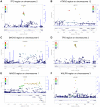Identification of novel genetic Loci associated with thyroid peroxidase antibodies and clinical thyroid disease
- PMID: 24586183
- PMCID: PMC3937134
- DOI: 10.1371/journal.pgen.1004123
Identification of novel genetic Loci associated with thyroid peroxidase antibodies and clinical thyroid disease
Abstract
Autoimmune thyroid diseases (AITD) are common, affecting 2-5% of the general population. Individuals with positive thyroid peroxidase antibodies (TPOAbs) have an increased risk of autoimmune hypothyroidism (Hashimoto's thyroiditis), as well as autoimmune hyperthyroidism (Graves' disease). As the possible causative genes of TPOAbs and AITD remain largely unknown, we performed GWAS meta-analyses in 18,297 individuals for TPOAb-positivity (1769 TPOAb-positives and 16,528 TPOAb-negatives) and in 12,353 individuals for TPOAb serum levels, with replication in 8,990 individuals. Significant associations (P<5×10(-8)) were detected at TPO-rs11675434, ATXN2-rs653178, and BACH2-rs10944479 for TPOAb-positivity, and at TPO-rs11675434, MAGI3-rs1230666, and KALRN-rs2010099 for TPOAb levels. Individual and combined effects (genetic risk scores) of these variants on (subclinical) hypo- and hyperthyroidism, goiter and thyroid cancer were studied. Individuals with a high genetic risk score had, besides an increased risk of TPOAb-positivity (OR: 2.18, 95% CI 1.68-2.81, P = 8.1×10(-8)), a higher risk of increased thyroid-stimulating hormone levels (OR: 1.51, 95% CI 1.26-1.82, P = 2.9×10(-6)), as well as a decreased risk of goiter (OR: 0.77, 95% CI 0.66-0.89, P = 6.5×10(-4)). The MAGI3 and BACH2 variants were associated with an increased risk of hyperthyroidism, which was replicated in an independent cohort of patients with Graves' disease (OR: 1.37, 95% CI 1.22-1.54, P = 1.2×10(-7) and OR: 1.25, 95% CI 1.12-1.39, P = 6.2×10(-5)). The MAGI3 variant was also associated with an increased risk of hypothyroidism (OR: 1.57, 95% CI 1.18-2.10, P = 1.9×10(-3)). This first GWAS meta-analysis for TPOAbs identified five newly associated loci, three of which were also associated with clinical thyroid disease. With these markers we identified a large subgroup in the general population with a substantially increased risk of TPOAbs. The results provide insight into why individuals with thyroid autoimmunity do or do not eventually develop thyroid disease, and these markers may therefore predict which TPOAb-positives are particularly at risk of developing clinical thyroid dysfunction.
Conflict of interest statement
I have read the journal's policy and have the following conflicts: Dr. Bruce M Psaty reported serving on a DSMB for a clinical trial of a device funded by the manufacturer (Zoll LifeCor) and on the Yale Open Data Access Project funded by Medtronic. All other authors have declared that no competing interests exist.
Figures

Similar articles
-
Association of established thyroid peroxidase autoantibody (TPOAb) genetic variants with Hashimoto's thyroiditis.Autoimmunity. 2016 Nov;49(7):480-485. doi: 10.1080/08916934.2016.1191475. Epub 2016 Jun 7. Autoimmunity. 2016. PMID: 27268232
-
The association of thyroid peroxidase antibody risk loci with susceptibility to and phenotype of Graves' disease.Clin Endocrinol (Oxf). 2015 Oct;83(4):556-62. doi: 10.1111/cen.12640. Epub 2014 Dec 22. Clin Endocrinol (Oxf). 2015. PMID: 25345847
-
The polymorphisms in the thyroid peroxidase gene were associated with the development of autoimmune thyroid disease and the serum levels of anti-thyroid peroxidase antibody.Endocr J. 2017 Oct 28;64(10):1025-1032. doi: 10.1507/endocrj.EJ17-0191. Epub 2017 Aug 25. Endocr J. 2017. PMID: 28845025
-
[The role of hereditary and environmental factors in autoimmune thyroid diseases].Orv Hetil. 2012 Jul 1;153(26):1013-22. doi: 10.1556/OH.2012.29370. Orv Hetil. 2012. PMID: 22735372 Review. Hungarian.
-
Conundrum for Psoriasis and Thyroid Involvement.Int J Mol Sci. 2023 Mar 3;24(5):4894. doi: 10.3390/ijms24054894. Int J Mol Sci. 2023. PMID: 36902323 Free PMC article. Review.
Cited by
-
Increased Circulating CXCL10 in Non-Segmental Vitiligo Concomitant with Autoimmune Thyroid Disease and Alopecia Areata.Ann Dermatol. 2019 Aug;31(4):393-402. doi: 10.5021/ad.2019.31.4.393. Epub 2019 Jul 1. Ann Dermatol. 2019. PMID: 33911617 Free PMC article.
-
Autoimmune thyroid disease and myasthenia gravis: a study bidirectional Mendelian randomization.Front Endocrinol (Lausanne). 2024 Feb 9;15:1310083. doi: 10.3389/fendo.2024.1310083. eCollection 2024. Front Endocrinol (Lausanne). 2024. PMID: 38405140 Free PMC article.
-
Vitamin D and thyroid function: A mendelian randomization study.PLoS One. 2024 Jun 20;19(6):e0304253. doi: 10.1371/journal.pone.0304253. eCollection 2024. PLoS One. 2024. PMID: 38900813 Free PMC article.
-
Identification of multiple novel susceptibility genes associated with autoimmune thyroid disease.Front Immunol. 2023 May 1;14:1161311. doi: 10.3389/fimmu.2023.1161311. eCollection 2023. Front Immunol. 2023. PMID: 37197658 Free PMC article.
-
Latent autoimmune thyroid disease.J Transl Autoimmun. 2020 Jan 8;3:100038. doi: 10.1016/j.jtauto.2020.100038. eCollection 2020. J Transl Autoimmun. 2020. PMID: 32743521 Free PMC article.
References
-
- Gough SC (2000) The genetics of Graves' disease. Endocrinol Metab Clin North Am 29: 255–266. - PubMed
-
- Tunbridge WM, Evered DC, Hall R, Appleton D, Brewis M, et al. (1977) The spectrum of thyroid disease in a community: the Whickham survey. Clin Endocrinol (Oxf) 7: 481–493. - PubMed
-
- Biondi B (2012) Mechanisms in endocrinology: Heart failure and thyroid dysfunction. Eur J Endocrinol 167: 609–618. - PubMed
Publication types
MeSH terms
Substances
Supplementary concepts
Grants and funding
- UL1 RR033176/RR/NCRR NIH HHS/United States
- N01 HC085080/HL/NHLBI NIH HHS/United States
- U01 HL080295/HL/NHLBI NIH HHS/United States
- R01 HL087652/HL/NHLBI NIH HHS/United States
- R01 HL105756/HL/NHLBI NIH HHS/United States
- HHSN268201200036C/HL/NHLBI NIH HHS/United States
- N01 HC055222/HL/NHLBI NIH HHS/United States
- N01 HC085079/HL/NHLBI NIH HHS/United States
- R01 HL080295/HL/NHLBI NIH HHS/United States
- P30 CA016058/CA/NCI NIH HHS/United States
- DK063491/DK/NIDDK NIH HHS/United States
- WT_/Wellcome Trust/United Kingdom
- HL080295/HL/NHLBI NIH HHS/United States
- N01 HC085081/HL/NHLBI NIH HHS/United States
- UL1RR033176/RR/NCRR NIH HHS/United States
- UL1TR000124/TR/NCATS NIH HHS/United States
- N01 HC085082/HL/NHLBI NIH HHS/United States
- R01 HG002651/HG/NHGRI NIH HHS/United States
- HL105756/HL/NHLBI NIH HHS/United States
- N01 HC085086/HL/NHLBI NIH HHS/United States
- N01 HC085083/HL/NHLBI NIH HHS/United States
- 085541/Z/08/Z/WT_/Wellcome Trust/United Kingdom
- HL087652/HL/NHLBI NIH HHS/United States
- UL1 TR000124/TR/NCATS NIH HHS/United States
- P30 DK063491/DK/NIDDK NIH HHS/United States
- P30 CA16058/CA/NCI NIH HHS/United States
- WT089062/WT_/Wellcome Trust/United Kingdom
- P01 CA124570/CA/NCI NIH HHS/United States
- R01 AG023629/AG/NIA NIH HHS/United States
- AG023629/AG/NIA NIH HHS/United States
- R56 AG023629/AG/NIA NIH HHS/United States
LinkOut - more resources
Full Text Sources
Other Literature Sources
Research Materials

